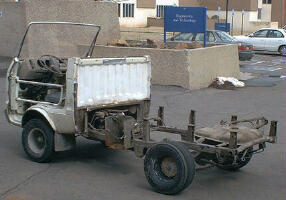
|
Our Donated Daihatsu Hijet (bed has been removed) THANKS to Facilities Management!!! |
|
| Design Approach and Philosophy | |
| For this project we will go through three different phases: | |
| 1) Solicitation for support | |
| 2) Design & Analysis | |
| 3) Production of prototype | |
|
When developing this vehicle, our BUV design team has some specific objectives in mind. The design should be focused on the end user. The vehicle will have features built into it that will enhance the quality of life for the operator. For example the parts and components will be designed so that they could be easily repairable. Most of the components should be made from generic steel stock so that the operator can repair it without a parts store. The size and volume of the vehicle are also concerns because of the distance these vehicles must be shipped. Failure modes and loads will also be a concern. The vehicle must be very rugged. The vehicle should also made so that other manufacturers can copy it. The goal of this project is not to make a monopoly, but to help third world countries.
|
|
|
|
|
| Solicitation Results | |
|
As a result from our first phase of this project (soliciting support), we have acquired stock steel from W.L Gore and C&D Mold. We have also obtained a vehicle from NAU's Facilities Management. The vehicle is a 1981 Daihatsu Hijet Truck (See figure 1 &2). We also aquired steel donations and many other offers for support.
|
|
| Daihatsu specifications: | 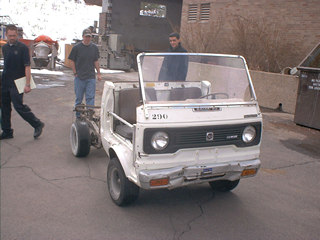 |
|
Engine: 547cc, 2 cylinder gasoline (max speed 25 mph) |
|
| Wheelbase: 70.75 in | |
| Bed: 72 in (length) | |
| Ground clearance: 6 in | |
| Close match to original design | |
| Our original design approach was a clean slate design of a BUV. We had completed our initial design of the during the fall 2000. This included frame dimensions, seating arrangement, engine placement and we also began looking at different suspension options. When we acquired the Daihatsu, it was very surprising to see how closely it resembled our original design. This resulted in a design decision to change our design approach from a clean slate to a modified design approach. | |
|
|
|
| Design |
Where
we started
|
| Our current design consists of using the existing chassis; frames, suspension, drive-train and other subcomponents of the Daihatsu Hijet. We will make modifications to the Daihatsu to resemble our vision of a BUV. | 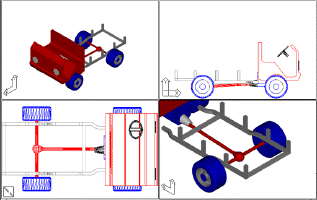 |
|
Modified bed- modifications will be made to accommodate two more passengers. This modification consists of adding a bench seat and a recessed region for leg room (See Figure 4&5).
|
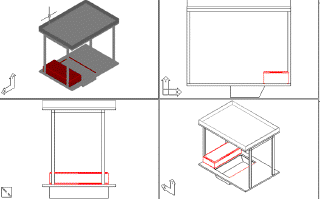 |
| Roof Rack-a frame supporting a roof rack will be added to bed of the truck. It will hold a maximum load of 300 lbs (See Figure 4&5). | |
| It will require a significant amount of welding, and has been analyzed for its strength (see Analysis) | |
|
Modification
Kit (above)
|
|
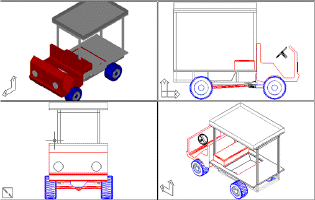 Daihatsu
and our kit as a modified design
|
|
| The BUV | |
| This is our vision of a BUV. It accomadates seating for 4 passengers, it is small, light weight and has a load capacity of 1000 lbs. This vehicle can be used to transfer goods to a market place or as transportation to a work place. It meets requirments as outlined by the IAT (see requirments by the IAT) | |
|
|
|
|
|
|
| Original Proposed Design | |
| Taking into consideration the nature of the vehicle, and the constraints of the project, a proposed design is as follows. The BUV design team proposes that the frame be made from ASTM A-36 1.5 inch box steel. The choice of steel as a frame material will help the vehicle meet the requirements that it be rugged and easy to come by in third world countries. The box configuration will help the vehicle be strong as well as cost effective. | 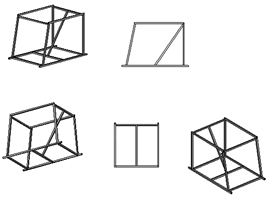 |
| The frame will be designed in the shape of a rectangular box. The passengers will ride in the middle, and the cargo will be placed above them. The power plant will be in the center with the seats facing forward with their backs to the engine. On the prototype, the floorboard and the roof will be made from steel or aluminum. However, the design for the production model is to have molded plastic sheets for these panels. The engine will have to be able to generate at least six horsepower at 1600 rpm in order to pull 770 lbs up a 15o incline. The tires will be placed on the far front and back of the vehicle for alternate use as bumpers. All of these specifications are reliant on the design requirements. The design of this vehicle is a constantly evolving process; therefore the actual vehicle may be different than the design proposed here. The refinements made during the next few months will be reflected in the final engineering report and will be identified. Fatigue analysis of the drive train and the suspension will be conducted and included in the final engineering report. The modes of failure and the failure loads will be noted. Special attention will be given to the transition from a prototype to a production vehicle. The prototype will have some configurations that will probably be different on the actual production vehicle. The design of the production version will be the focus of our work. However, when the production version needs something that would be unrealistic for the prototype, the final design will document the difference. | |
